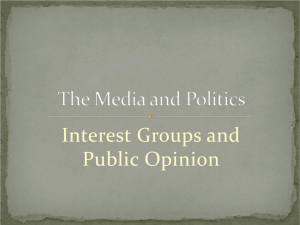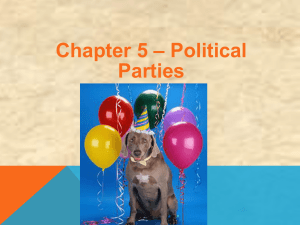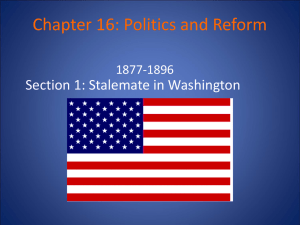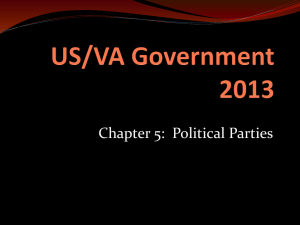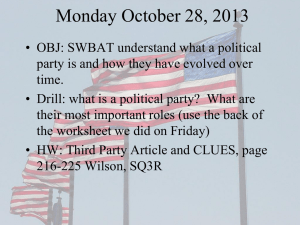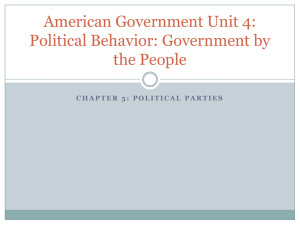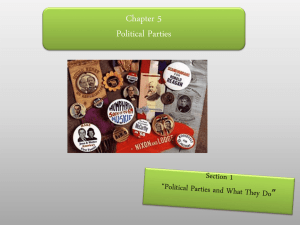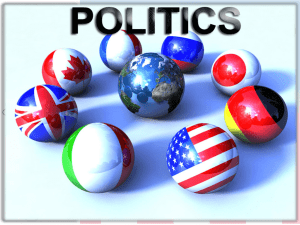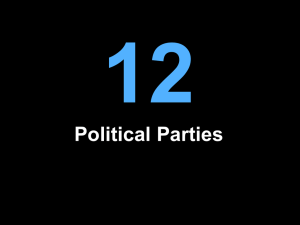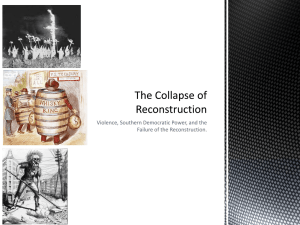File
advertisement
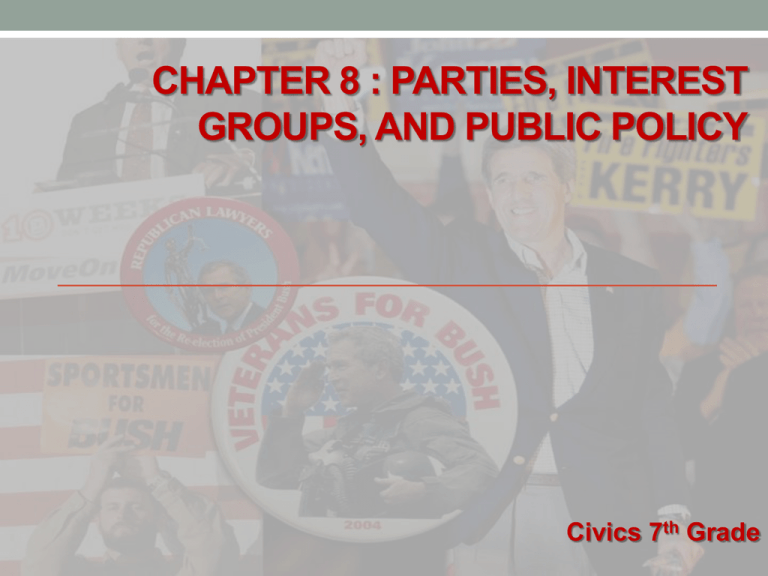
CHAPTER 8 : PARTIES, INTEREST GROUPS, AND PUBLIC POLICY Civics 7th Grade Chapter 8 Florida Standards: SS.7.C.2.8 Identify America’s current political parties, and illustrate their ideas about government. SS.7.C.2.10 Examine the impact of media, individuals, and interest groups on monitoring and influencing government (The media portion of this standard will be covered in the next TCI chapter) SS.7.C.2.13 Examine multiple perspectives on public and current issues LACC.68.RH.2.4 Determine the meaning of words and phrases as they are used in a text, including vocabulary specific to domains related to history/social studies. LACC.68.WHST.2.6 Use technology, including the internet, to publish and produce your plan and present the relationships between information and ideas clearly and effectively. LACC.68.WHST.3.8 Gather relevant information from multiple print and digital sources, using search terms effectively; assess the credibility and accuracy of each source; and quote or paraphrase the data and conclusions of others while avoiding plagiarism and following a standard format of citation. Terms that you must know before moving on: Political party – An organization that seeks to achieve power by electing its members to public office. E.g.: Democrats, Republicans. Interest group – Any organized group whose members share a common goal and try to promote their interests by influencing government policymaking and decision making. E.g.: National Rifle Association (NRA), World Wildlife Fund (WWF). CHAPTER 8 : PARTIES, INTEREST GROUPS, AND PUBLIC POLICY SECTION 2: POLITICAL PARTIES IN THE UNITED STATES Pages 142 - 147 What Do Political Parties Do in a Democracy? The primary goal of parties is to get their candidates elected to office. However, they also have a number of other functions, such as:. 1. Parties recruit candidates and support campaigns. Each year, political parties seek out and enlist candidates to run for thousands of local, state, and national offices. Political parties also provide some funding for candidates. 2. Parties help organize elections and inform voters. Political parties help promote voter interest and participation. They also help inform voters on political issues. 3. Parties organize the government. Members of the majority party in Congress choose one of their members to be speaker of the house or Senate majority leader. Committee chairpersons in Congress also come from the majority party. What Do Political Parties Do in a Democracy? 4. Parties unite diverse interests and make collective action possible. Parties bring diverse groups together by building coalitions based on shared beliefs and common goals. Delegates attending national party conventions create platforms (i.e.: a political party’s statement of principles and objectives) that outline the party’s position on important issues. 5. Parties serve as a loyal opposition to the political party in power. The goal of a political party is to win control of the government so that it can translate its objectives into laws and policies. Minority party members act as a “loyal opposition” and the critics of the majority party’s proposals. They also serve as government watchdogs, always on the lookout for corruption or abuses of power. The Structure of Political Parties: Local, State, and National Both major political parties in the United States are organized at the local, state, and national level. Committees manage the affairs of the party at each level. Page 143 The Structure of Political Parties: Local, State, and National • precinct - a local voting district of a city or town. • Political parties offer various ways for citizens to get involved in politics. • The most common way is through voter registration. Most Americans identify with one party or the other, and they register to vote as a member of that party. • Citizens can also donate money to a political party or its candidates and attend party rallies or meetings. • In addition, some citizens volunteer to work on party committees or individual campaigns. The Evolution of the Two-Party System • In 1787, when the Constitution was written, no political parties existed in the United States. • Before long, the nation’s leaders had begun to divide into groups with differing views. These groups soon gave rise to the nation’s first political parties. • By the early 1800s, a political system based on two major parties emerged. This two-party system (i.e.: a political system in which two parties dominate the electoral process and control the government) has endured to the present day. The Evolution of the Two-Party System The first parties formed: Page 144 The Federalists: by Alexander Hamilton. They favored a strong national government and drew their support largely from commercial and industrial interests in northern cities. The Democratic-Republicans: by Thomas Jefferson. They favored a weaker national government and strong state governments. They gained the backing of farmers and rural interests in southern states. In 1796, after losing the election, the Federalist Party slowly disappeared. In the 1820s, disgruntled members of the Democratic-Republicans Party broke away and formed a new political faction (group) called the National Republicans Party (later known as the Whig Party). Around the same time, the remaining Democratic-Republicans became known simply as Democrats. In the 1850s, the issue of slavery deeply divided the Whigs, and their party soon fell apart. A number of former Whigs joined with antislavery activists to form the Republican Party in 1854. The Republicans established themselves as the nation’s second major party. The Democratic and Republican parties have dominated American politics ever since. The Two-Party System Today Over the years, the two parties have evolved and changed, and so have their bases of support. For example, the Democrats were once the strongest party in the South. Today the Republicans generally enjoy more support among southern voters. Page 145 Republicans and Democrats in the Twenty-first Century • Republicans hold more conservative views, and Democrats more liberal views. Democrats Size of the National Government Taxes Regulation of Business Social Issues Minimum Wage Republicans Support a strong federal government & look to it to solve problems. Support a weak national government & giving more power to the states to solve problems Favor tax cuts for the poor, while raising taxes for affluent Americans in order to support programs that they see as beneficial to society. Favor tax cuts to encourage economic growth & to allow people to keep what they earn. Support government regulation of business as a way to protect consumers, workers, or the environment. Oppose what they see as excessive business regulation by the government. Support abortion rights and gun control laws, while opposing school prayer. Favor prayer in public schools, while opposing abortion and gun control laws. Favor regular increases in the minimum wage to support poor families. Tend to oppose minimum wage laws as unnecessary economic regulation. Third Parties: Single-Issue, Economic Protest, Ideological, and Splinter Groups Not all Americans identify with the two major parties. There are four main types of third parties in the United States. Page 146 Third Parties: Single-Issue, Economic Protest, Ideological, and Splinter Groups • Third parties have advocated reforms that have eventually been adopted by the major parties. In the 1990s, for example, the Green Party helped raise awareness of environmental issues. Today “green” positions on the environment can be found in the platforms of the two main parties. • However, third parties face an uphill battle given the strength of the two-party system. Smaller parties find it hard to raise money and get the media coverage they need to challenge the two major parties. The Moderate Middle: Centrist and Independent Voters • In recent years, a growing number of Americans have declared themselves to be political independents. That means that they are not aligned with any political party. • Because they turn away from the more liberal or conservative views of the two major parties, they are referred to as “centrists”, or middle-of-the-road. • Although these voters call themselves independent, they lean toward one or the other major party and still vote like either Democrats or Republicans. CHAPTER 8 : PARTIES, INTEREST GROUPS, AND PUBLIC POLICY SECTION 3: INTEREST GROUPS IN AMERICA Pages 147 - 151 Interests Groups in America • Americans join all kinds of groups that reflect their interests. • When such groups seek to influence government, at any level, they are called special-interest groups or special interests. • special interests (i.e.: a group that seeks to influence government policymaking and decision making to further its particular goals; also known as an interest group). Are Interest Groups Good or Bad for Democracy? • Many Americans distrust special interests because they believe that these groups seek to achieve their goals at the expense of society as a whole. • More than two centuries ago, James Madison addressed this question in The Federalist Papers. He wrote that “factions” (interest groups) posed a threat to democratic government if their power went unchecked. The key issue was how to contain the threat while preserving liberty. • Madison believed that pluralism held the answer. • pluralism - the idea that political power should be distributed and shared among various groups in a society. • According to Madison, interest groups competing in a pluralistic society should act as a check on tyranny and make government more representative. Are Interest Groups Good or Bad for Democracy? • Today, interest groups… • 1. offer Americans a way to participate in the political process. • 2. speak out on issues of concern to their members and the public at large. • 3. present specialized information to government officials. • 4. monitor government actions to ensure that the rights and interests of their members are protected. • 5. help keep people informed about their government. • Even though special interests occasionally influence the political system in negative ways, they play a critical role in the democratic process. What Kinds of Interest Groups Do Americans Join? • Interest groups all try to persuade elected officials to take actions to support their interests. Specialinterest groups fall into several categories, depending on their membership and goals. • This table highlights four such groups. What Kinds of Interest Groups Do Americans Join? • Special-interests groups categories consists of: • Economic interest groups - This category includes business groups, trade organizations, professional associations, and labor unions. • Citizen groups – They promote the public interest. Some of these groups may also be motivated by a particular ideology or set of issues. • Government interest groups – They exist at every level of government. They include groups like the National Governors Association, public employee unions, and groups that represent mayors or city managers. • There are other categories, as well, such as foreign policy interest groups, nationality groups, and religious organizations. At the same time, many special interests, do not fall neatly into any particular category. Nonetheless, such groups may be large and highly influential. Why Do People Join Interest Groups? • Americans join interest groups for various reasons. Some join for the information and benefits the groups offer. • Americans also join interest groups because they agree with the group’s goals and want to be part of a larger community of shared interests. How Are Interest Groups Organized and Funded? • All interest groups need both money and people, but they are organized and financed in many ways. • Most interest groups have an elected board of directors or trustees who set policy and decide how the group’s resources will be used. Many groups have both national and state chapters, each led by their own boards or trustees. • Many economic and single-issue groups get most of their operating expenses from dues, membership fees, and direct mail fundraising campaigns. • Some public interest groups get their primary funding from foundations or government grants. The Rise of Political Action Committees • One way that interest groups try to influence government is by contributing money to political parties and candidates during election campaigns. • Campaign finance laws passed by Congress in the early 1970s placed limits on some types of campaign contributions. But these laws allowed the creation of new funding organizations called political action committees (PACs). • political action committees (PACs) - an organization that raises and distributes funds to candidates running for office. The Rise of Political Action Committees • By law, PACs are allowed to collect donations and funnel that money into political campaigns. • Many Americans believe that PAC campaign contributions give interest groups too much influence over elected officials. Nevertheless, most research shows that PAC money does not buy votes in Congress. It does, however, give contributors greater access to lawmakers. Page 149 How Do Interest Groups Influence Policy? • Campaign contributions are one way interest groups try to influence government policy. But they have other, more powerful methods as well, such as lobbying, research, litigation, and grassroots mobilization. • Lobbying. Lobbying is an organized effort to influence the policy process by persuading public officials to favor or oppose action on a specific issue. Lobbyists speak to members of Congress and their staffs, testify before congressional committees, and offer comments at hearings held by executive agencies. Often they provide useful information that helps officials create policies that serve the public interest. How Do Interest Groups Influence Policy? • Research and policy proposals. Some interest groups carry out research and write policy proposals that support their goals. In some cases, they work with think tanks (i.e.: an organization of scholars and policy experts who study public issues and write articles and books summarizing their research) to carry out this research. Interest groups use these expert findings to influence government officials. • Litigation. Interest groups may also try litigation (i.e.: the process of bringing a lawsuit against someone), or the bringing of lawsuits, to influence policy. (E.g.: National Association for the Advancement of Colored People, in the 1954 Supreme Court case of Brown v. Board of Education) How Do Interest Groups Influence Policy? • Grassroots mobilization. Another way interest groups try to influence policy is through grassroots mobilization (i.e.: the rallying of strong and vocal support from a large group of people at the local level). • Grassroots mobilization often takes the form of public demonstrations, such as protests or rallies. Increasingly, however, it is carried out by mail or over the Internet. Interest groups call on members to write cards or flood the e-mail inboxes of public officials with messages urging a particular course of action. What Makes an Interest Group Powerful? Size and money are key factors, but other criteria can also play a role. • Size and money. With ample funds, interest groups can afford to maintain offices around the country, hire a large staff, and pay travel and lobbying expenses. They can also produce expensive media ads to raise their public profile. • Unity of purpose. When the members of an interest group are united on an issue, their voices are usually heard by government leaders. • Effective leadership. Effective leaders can clearly express the group’s message and win support from others. Without effective leadership, even a group with a powerful message may fail to achieve its goals. • Information and expertise. Successful interest groups know how to gather and analyze information and deliver it to decision makers. CHAPTER 8 : PARTIES, INTEREST GROUPS, AND PUBLIC POLICY SECTION 4: MAKING PUBLIC POLICY Pages 152 - 155 Making Public Policy Public policy refers to government actions or programs designed to achieve certain goals. Creating public policy is a multistep process. Government officials, policy experts, political parties, interest groups, and concerned citizens all take part in such policymaking. public policy - a plan or course of action initiated by government to achieve a stated goal. How the Policy Making Process Works Seeing What Needs Attention: Issue Identification • The first step in policymaking is identifying problems and issues that need to be addressed. Sometimes a crisis brings an issue to public attention. • Public officials can also raise awareness of issues. Choosing Issues to Address: Agenda Setting • Agenda setting requires officials to decide which issues should be part of the public agenda. • public agenda - a set of priorities for public action. • Some issues pop onto the public agenda as a result of a disaster. • E.g.: The 9/11 terrorist attacks on the World Trade Center and the Pentagon put fighting terrorism high on the nation’s public agenda. • Political parties and interest groups often play a role in setting the public agenda. Parties help by placing issues on their platforms, thus making those items a priority for the candidates they elect. Interest groups do the same by lobbying for certain issues. Deciding What to Do: Policy Formulation • This step may take place within any branch of government. It can also happen at the local, state, or national level. • Legislatures or city councils make policy by passing laws or statutes. • Executive officials or agencies make policy by setting new rules and regulations. • The judicial system can influence policy, too, through court decisions and rulings. • Officials may ask experts to offer their opinions. • They may also invite interest groups to present their views. Putting Proposals into Action: Policy Adoption • Many policies are formulated as legislation. • These bills must first pass through Congress, state legislatures, or city councils to become law. • This legislative process often results in substantial revisions. • A policy proposal may be changed to gain the support of a majority of legislators. Or it may be modified to avoid legal challenges or a threatened veto by a governor or president. Making a Policy Work: Implementation • After a policy is adopted, it must be implemented. • Usually, implementation is assigned to a specific government agency. That agency then becomes responsible for making the new policy work. • E.g.: After the 9/11 terrorist attacks, Congress enacted a number of antiterrorism policies. The job of implementing these policies was given to the newly created Department of Homeland Security. Assessing the Effectiveness of a Policy: Evaluation • The final step in the policy process is evaluation. • Government officials and concerned interest groups assess whether implemented policies have met their goals. • If changes need to be made, the policymaking process begins again.
